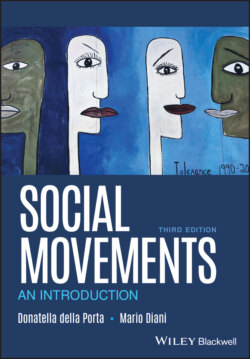Читать книгу Social Movements - Donatella della Porta - Страница 10
1.1.3 How Is Collective Action Possible?
ОглавлениеIn deliberate contrast to conceptualizations of social movements as irrational, largely reactive phenomena, some American sociologists in the 1970s started to reflect on the processes by which the resources necessary for collective action are mobilized. In their view, collective movements constitute an extension of the conventional forms of political action; the actors engage in this act in a strategic way, following their interests; organizations and movement “entrepreneurs” have an essential role in the mobilization of collective resources on which action is founded. Movements are therefore part of the normal political process. Stressing the external obstacles and incentives, numerous pieces of research have examined the variety of resources to be mobilized, the links which social movements have with their allies, the tactics used by society to control or incorporate collective action, and its results. The basic questions addressed relate to the evaluation of costs and benefits of participation in social movement organizations.
In early contributions in this vein, Mayer Zald (McCarthy and Zald 1987; Zald and Ash 1966), Anthony Oberschall (1973, 1980) and Charles Tilly (1978) defined social movements as rational, purposeful, and organized actions. Collective action derives, according to this perspective, from a calculation of the costs and benefits, influenced by the presence of resources – in particular, by organization and by the strategic interactions necessary for the development of a social movement. In a historical situation in which feelings of unease, differences of opinion, conflicts of interest and opposing ideologies are always present, the emergence of collective action cannot be explained simply as having been caused by these elements. It is not enough to discover the existence of tensions and structural conflicts: we also have to study the conditions which enable discontent to be transformed into mobilization. The capacity for mobilization depends on the material resources (work, money, concrete benefits, services) and/or nonmaterial resources (authority, moral engagement, faith, friendship) available to the group. These resources are distributed across multiple objectives according to a rational calculation of costs and benefits. Beyond the existence of tensions, mobilization derives from the way in which social movements are able to organize discontent, reduce the costs of action, utilize and create solidarity networks, share incentives among members, and achieve external consensus. The type and nature of the resources available explain the tactical choices made by movements and the consequences of collective action on the social and political system (Edwards and McCarthy 2004; McCarthy and Zald 1987).
The existence of solidarity networks once again questioned a widely spread assumption at the time, namely, that movement recruits are mainly isolated and rootless individuals who seek to immerse themselves in the mass as a surrogate for their social marginalization. According to rational approaches, mobilization can thus be explained as being more than the gratification of pursuing a collective good; it also promotes the existence of horizontal solidarity links, within the collective, and vertical links, integrating different collectives. On the basis of a wide range of empirical research, one can therefore foresee this phenomenon:
Participants in popular disturbances and activists in opposition organizations will be recruited primarily from previously active and relatively well‐integrated individuals within the collectivity, whereas socially isolated, atomized, and uprooted individuals will be underrepresented, at least until the movement has become substantial.
(Oberschall 1973, p. 135)
Accordingly, scholars of resource mobilization concentrate their attention on how collective actors operate, how they acquire resources and mobilize support, both within and without their adherents’ group.
Over the years, research on social movement organizations has extended its attention to the relations between organizations and the dynamics going on in organizational populations. Increasingly sophisticated network studies have looked at the interactions between the organizations and individuals identified with social movements (Diani 2015; Diani and McAdam 2003; Krinsky and Crossley 2014; Mische 2008). Concepts and methods borrowed from organizational theory have been applied to the study of the factors behind organizations’ emergence and survival, again with reference to both the national and the global sphere (Atouba and Shumate 2010; Davis et al. 2008; Den Hond, De Bakker, and Smith 2015; Smith et al. 2018; Smith and Wiest 2012; Wijk et al. 2013).
The definition of social movements as conscious actors making rational choices is among the most important innovations of the resource mobilization approach. However, it has been the target of several criticisms. It has been charged with indifference to the structural sources of conflict and the specific stakes for the control of which social actors mobilize (Melucci 1989; Piven and Cloward 1992). Its emphasis on the resources controlled by a few political entrepreneurs, at the cost of overlooking the self‐organization potential by the most dispossessed social groups, has also been criticized (Piven and Cloward 1992). Finally, it has been noted that in its explanation of collective action this approach overdoes the rationality of collective action, not taking the role of emotions adequately into account (Goodwin, Jasper, and Polletta 2001). In fact, as some of the most influential proponents of this approach admitted, “early resource mobilization models exaggerate the centrality of deliberative strategic decisions to social movements” (McAdam, Tarrow, and Tilly 2001, p. 7), overemphasizing similarities between social movements and interest politics. As in organizational sociology neo‐institutionalism focused attention to appropriateness rather than rationality, also social movement studies tended to give more attention to the importance of norms over means and on prefiguration as anticipation of the future (Tavory and Eliasoph 2013).
